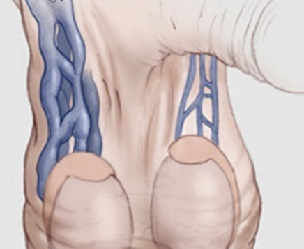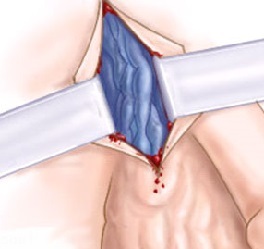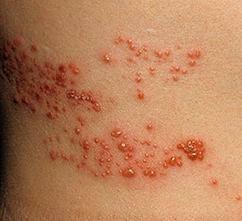 Varicocele - varicose veins of the spermatic cord and testicle. This is one of the most common diseases among men, which often leads to very unpleasant consequences.
Varicocele - varicose veins of the spermatic cord and testicle. This is one of the most common diseases among men, which often leads to very unpleasant consequences.
In itself, varicose veins of the spermatic cord do not pose a threat to life, and often do not require treatment.
However, sometimes varicocele can cause infertility, because it affects the quality and quantity of sperm produced. Of all men who have infertility problems, about 40 percent are affected by this ailment, at least on one testicle. Most often this disease affects boys in the middle of puberty.
Mostly from the varicocele, the left testicle of a man begins to suffer, and far less often the right one. Disease, as a rule, develops during puberty of a boy and for a very long time can not manifest itself in any way.
Causes
Why develop varicocele, and what is it? The cause of varicocele may not be enough good work of the valves of the veins of the spermatic cord. Venous valves, normally hindering the return flow of blood, under increased stress (physical stress, vertical position of the body) do not cope with the increased pressure. Because of the increased pressure, the veins gradually expand, eventually forming tumor-like venous nodes.
In more than 80% of all cases varicocele is formed from the left testis. Usually, pathology begins to develop in adolescent boys aged 10-12 years and can become noticeable at about 14-15 years.
Degrees
Given the intensity of the lesion of the venous system of the scrotum, known such varicocele degrees:
- Initial degree. Externally, there are no signs of venous disease, but pathological changes are visible with ultrasound Doppler study.
- 1 degree. Extended vessels are not visible and palpation is not noticeable. You can see them when straining - the Valsalva test.
- 2 degree. The blood vessels are enlarged, visually invisible, but well groped when palpated.
- 3 degree. The enlarged venous mesh is clearly visible on the scrotum and palpated during palpation.
Varicocele 1 degree
Varicocele of the first degree may be accompanied by a dysfunction of the testicle. The parameters of the ejaculate are studied: consistence, volume, number of spermatozoa, relative percentage of mobile and immobile spermatozoa, which is extremely important for the diagnosis of male infertility. Despite the absence of symptoms, varicocele 1 degree needs surgical treatment, especially for young men, who plan to have a baby in the future.
Varicocele 2 degrees
Varicocele 2 degrees can be determined only in the standing position of the patient, as well as with physical exertion. In a calm standing and lying position, there are no signs of varicocele. In this case, it is also appropriate to perform an instrumental examination and pass the analysis to the spermogram. The second degree of varicocele indicates the development of the disease.
Varicocele 3 degrees
With varicocele of 3 degrees, varicose veins are visible even to the naked eye and in any position. At this stage of the disease, the scrotum acquires a testy character, since in the standing position the dilated blood vessels reach the very bottom of the musculoskeletal formation and deform them. The glands can have a strong puffiness.
Patients with varicocele of grade 3 suffer permanent pain that does not stop under the influence of analgesics. The skin of the scrotum inflames to a purple hue, the affected organ is markedly reduced, and the groinlike venous weave on it becomes stiff. The severe stage of the disease requires surgical treatment.
Symptoms
Men should pay attention to such signs, which can indicate varicocele testicles.
- visible or palpable (with palpation) enlarged vein;
- pulling and aching pain in the scrotum;
- a feeling of heaviness in the testicle (s);
- atrophy (contraction) of the testicle (ek);
- higher testosterone levels (although testosterone levels seem to grow further after varicocelectomy).
Symptoms of varicocele
 Varicocele symptoms are usually weak. Disease in men can flow and completely without noticeable symptoms. Usually, the varicocele is manifested with a slight, swelling or drawing pain in the testicle.
Varicocele symptoms are usually weak. Disease in men can flow and completely without noticeable symptoms. Usually, the varicocele is manifested with a slight, swelling or drawing pain in the testicle.
In the vertical position, the pain intensifies. Exacerbation of pain is observed with physical exertion. Pathology can manifest only a certain feeling of heaviness in the scrotum without pain. There may be lack of mobility, a drop in the testicle.
In the analysis, the weakness of spermatogenesis is diagnosed in most cases. For the diagnosis, the following methods are used: ultrasound, palpation of the lobate plexus, and also carry out a Valsalva test.
Consequences of varicocele
As we have already said, the disease itself does not pose a threat to the life of the patient, but complications that can still occur are the pain symptom and male infertility.
Factors of infertility in this disease are as follows:
- testicular ischemia;
- temperature increase testicular to the body temperature;
- accumulation in the testicles of free radicals, which damage these tissues;
- throwing biologically active substances in the testicles of the adrenals and kidneys.
It is possible that complications will arise after the operation, although this does not happen often. The most common consequence after surgery is lymphostasis. This is due to the fact that lymphatic vessels are damaged. This complication disappears within a week.
Preventive measures
To reduce the expansion of the veins of the spermatic cord, it is necessary to eliminate stasis formed in the organs of the small pelvis. Thus, effective prevention measures are:
- normal stool;
- strongly not overexert;
- regular sex life;
- rejection of bad habits;
- physical activity;
- sport;
- more fresh air and walks;
- proper nutrition;
- reception in a diet of vitamins.
Treatment of varicocele
 When varicocele treatment, as well as diagnostics are dealt with by surgeons or urologists.
When varicocele treatment, as well as diagnostics are dealt with by surgeons or urologists.
Treatment of pathology is only surgical, the main indications for the operation:
- impaired sperm quality;
- discomfort or pain in the scrotum;
- aesthetically unsatisfactory genitals;
- testicular atrophy.
Several methods of surgical intervention have been suggested for this:
- Embolization of blood vessels (in other words, blocking them). The advantages of this method are the rapid recovery, the absence of seams from the operation. The disadvantage of the method is the possibility of blood flow along the bypass and recurrence.
- Laparoscopic operation (introduction of micro-instruments through small punctures with vein ligation).
- Surgical correction of varicocele (with the possibility of microsurgical access and full operation). It is mainly performed in complicated cases.
The essence of all operations is to reduce the transfer of blood to the testicle by means of its ligation or redirection of the current into other, smaller veins.
How to treat varicocele without surgery? Not surgical treatment is possible only in the early stages and is ineffective. Includes wearing supportive swimming trunks, as well as medications that improve the tone of the veins.
Possible complications after surgery for varicocele
After performing a surgical procedure for varicocele, in some cases the following unpleasant complications can occur:
- In the early postoperative period, ligation and damage to the lymphatic vessels can provoke lymphostasis.
- The most terrible complication of surgical treatment varicocele may be atrophy or testicular hypotrophy. This phenomenon can provoke a random dressing of the spermatic artery.
- After the operation, the pain decreases or disappears in 90% of cases, however, every 3-5 men from 100 operated continue to worry about pain in the testicle and spermatic cord.
- Intersection of lymphatic vessels in ½-4 years after the operation, and sometimes in the first months, in , -9% of patients can cause a dropsy.
- In adult men, the recurrence of the disease is observed less frequently than in children - 2-9% and 1-20%, respectively.
The success of varicocele treatment is indicated by the improvement in the quantitative and qualitative characteristics of the sperm observed after the operation, usually in 3-6 months.

How to choose probiotics for the intestine: a list of drugs.

Effective and inexpensive cough syrups for children and adults.

Modern non-steroidal anti-inflammatory drugs.

Review of tablets from the increased pressure of the new generation.
 Antiviral drugs are inexpensive and effective.
Antiviral drugs are inexpensive and effective.



